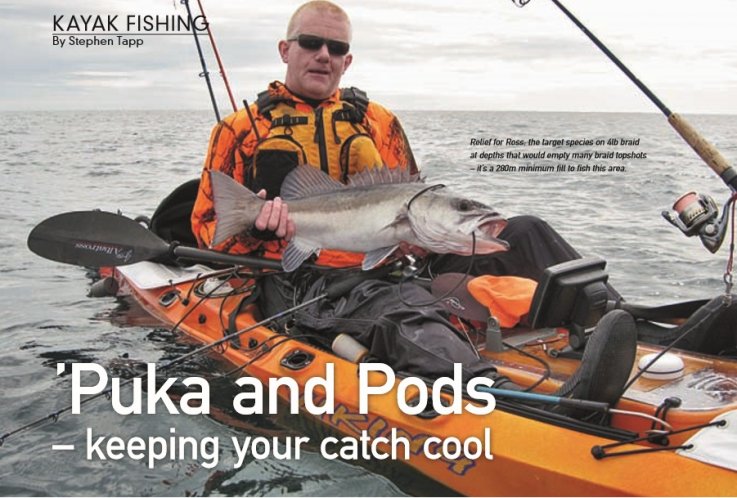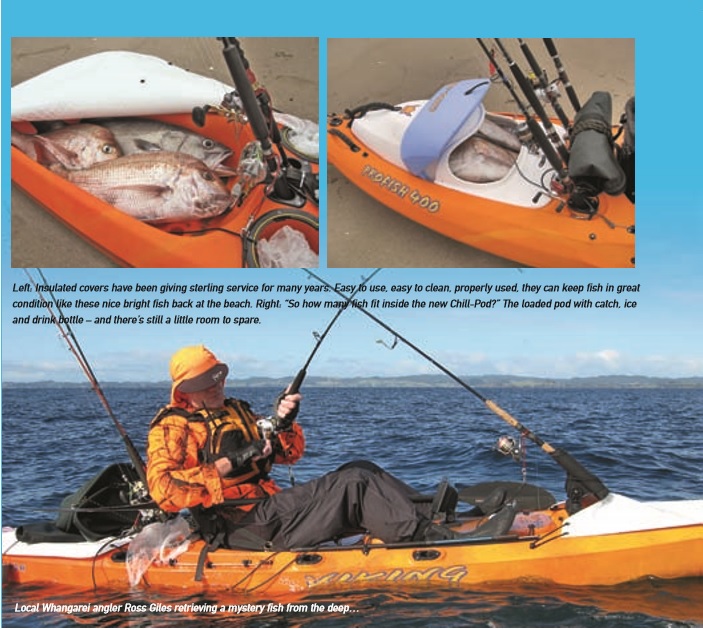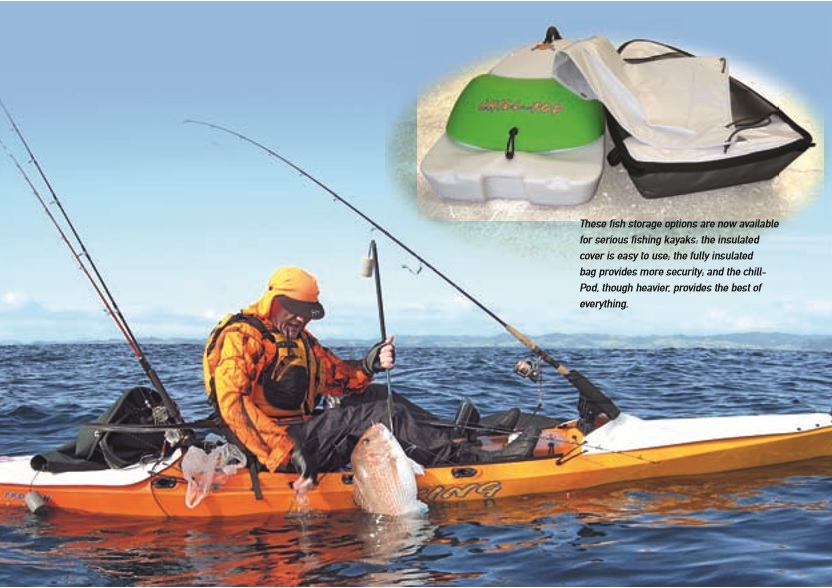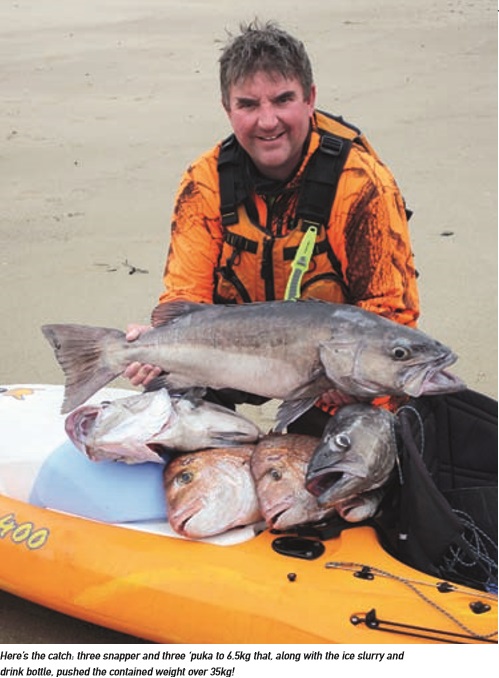Keeping Catch Cool & Fresh
10:37PM 6th Nov 13

“So, these new Chill-Pods for the Profish 400 – how many fish can you fit in there and does it really keep them any colder?”
Well, if there were ever a couple of questions giving an excuse to go fishing, there they were – I had to find out how many fish the Chill-Pod would comfortably fit when slid on top of a few kilos of flake ice, and whether they stayed in top condition. It would be a fantastic opportunity to round out a comparison of insulated well covers, partially and fully insulated fish bags, and insulated pods.
Continue reading this trip report after the outline of Viking Kayak products designed for keeping your fish contained and fresh...
Insulated covers
Designed to cover the top of the rear well of fishing kayaks, these covers have an insulating foam core. They’re lightweight, easy to use and clean, and easily accommodate awkward or long shapes. For those targeting big fish in rough water (especially in the surge zone close around structure), insulated covers offer the safest way to get fish aboard and out of the sun. They offer surprisingly good insulation for short to medium duration trips. For those on longer expeditions, fitting a set of scupper plugs to stop water cycling through the well allows you to add a bag or two of flake ice to chill your catch. This will easily double your time on the water before your valuable catch starts to suffer in the heat. Those of us spending full days on the water tend to leave keeping any of our catch until later in the day, releasing all those caught earlier in the session.
Insulated fish bags
These are available in two forms: a plain bag with insulated top and a fully-insulated bag. The plain bags with insulated tops are great for kayaks with shallow wells as they ‘flat pack’ until needed. The fully-insulated bags are more bulky but provide much better insulation. They are the lightest option for those needing to carry ice for longer periods. On the downside, the typical zippered openings of insulated fish bags aren’t as convenient as the flip-to one-side cover when it comes to getting big fish on board in rough conditions.
On the plus side, and most significant for those doing lots of surf transitions, the zippered bags keep your catch totally secure if you ‘turtle’ in the waves when returning to the beach. Though they’re very effective, the most common complaint with insulated bags is the need to periodically deodorize them. There’s also the potential for them to start leaking as they age, making it a very good idea not to rely on them keeping fish juices from seeping into the car boot when transporting your catch home!
Insulated pods
Purpose-designed insulated pods are becoming more available for advanced fishing kayaks. They offer the advantages of carrying ice on board (particularly for longer trips), excellent insulation, and easy cleaning. Molded to fit, insulated pods can be securely fastened for surf transitions and typically offer less windage than a chilly bin strapped in the rear well. Insulated pods are heavier than insulated fish bags (typically twice to three times as heavy), but are great at containing your catch and ice during the drive home – no more fishy leaks into the back of the vehicle. For those on single-day fishing excursions, this makes it possible to leave the larger ice chest or esky at home, but I prefer to pack my catch in flake ice even though it’s been chilled in the pod. This keeps the catch in top-notch condition and ensures it’s properly ‘set’ when it hits the filleting table.
Click HERE to find out more about our Fish storage options

Trip report continued....
A quick scan of the weather forecasts, a phone call, and a plan was hatched. I have a tiny spot not far from the Poor Knights Islands that produces solid snapper and pup ’puka through to late spring. Ross Giles from Whangarei would tag along in his fully-equipped kayak, giving us dual communication, safety and navigation equipment for the offshore paddle.
A dawn departure saw us on our way. The hardest part of the long paddle was ignoring all the fish sign showing on the sounder. It’s definitely a case of, “No, the fishing will be better out there, so keep paddling. If you put baits in the water you’ll never get there. DON’T STOP!”
Our arrival on the tiny mark in the middle of nowhere was heralded by a sudden change from mid-water baitfish schools to fish closely associated to the few square metres of low foul we would be fishing. All the necessary signs were there, and a quick circuit with the sounder had no difficulty in showing where the ’puka were hiding – distinct low-slung fish arches lurking just under the densest edge of the bait- fish school, right where the harder bottom transitioned back into the soft stuff. The problem was going to be getting the baits past all the hungry snapper lurking above!
For me this is a spot that fishes best using light braid, pilchards and 1oz stray-line rigs. Yes, to some this sounds like a strange ’puka combo for these depths, but I haven’t found traditional ledger rigs as effective here. The trick is to mark your target fish on the sounder, get on top of it, hit free-spool on the reel, then paddle on station as the bait descends.
With the rod angled across your shin, the trick is to keep the line vertical and free flowing off the tip. This ensures you’re staying on the mark so your bait hits the target. It also helps restrict the pillie from ‘swimming’ down, plummeting instead, minimizing the snapper by catch ’problem’ (for some reason a vertically dropping pillie is less attractive to snapper compared to one drifting or swimming down at an angle in this area).
As my first bait was dropping, I got a little distracted and let the kayak drift, allowing angle in the line. Suddenly the line sped up about 60m down – I’d attracted a snapper, and this 3kg fish quickly hit the ice in the Chill-Pod. However, I got my act together for the next bait – the sinker had only just kissed the bottom and WOOF, ’puka on!
These pups on light braid are capable of pulling lots of string! A nice 5.5kg ’puka eventually surfaced, and I got a Kevlar padded thumb-hold on the bottom jaw (if you value keeping your skin, don’t try this bare-handed!). A quick session with the hook-out pliers and a journey along the fish stringer cord quickly had this charcoal-backed beauty on ice in the Chill-Pod.

The comparison of fish storage systems had properly begun. The next few baits delivered snapper to 5kg (another was kept as it showed signs of severe decompression sickness), along with a solid golden snapper. It was time to get serious again, and scanning around with the sounder soon had another of those low-slung arches isolated. This time I dropped the bait fair down the ’puka’s throat! The line stormed off as the fish ran out onto the mud, leaving me with a burnt thumb – time to cringe and hope the leader knot was good enough!
The freight train finally slowed though, and I started to gain line. This fish eventually went 6.5kg on the lie detector. Back to the marks, and another pillie was sent on its way. Several of the mid-water snapper gave chase, and the curving lines trailing the bait had my heart in my mouth! They left it unmolested though, and when the sinker struck the hard stuff I knew I was in with a chance. Less than 15 seconds later the rod tip curved over and the pressure came on as another pup ’puka swam for the mud!
This is what makes this spot ideal for fishing light 2-4kg braid: the area of low foul has no pinnacles, and hooked fish inevitably run out onto the softer ground. There’s no apparent structure for them to rub the traces or leaders on, and it’s just a matter of patience and self-control to win the battle. But push too hard and you’ll get busted off on this light gear. (Those who believe ’puka don’t fight, need to experience fishing like this to appreciate what they’re truly capable of.) After a torrid battle I had the feisty little fish on the surface.
At 4kg it was the smallest of the three ’puka I allowed myself for the day, but it certainly had a ‘never say die’ attitude, even managing several mid- water runs that had me thinking 20lb snapper! A quick thread of the fish stringer and it too was on the Chill-Pod’s ice. I now had a mixed bag of five in there. Time to get one for Ross. At the beginning of this battle he’d seen me hook up, and in disgust yelled out, “Tapp, you bugger, why can’t I catch any!”
As mentioned, the secret to fishing here is getting right over the marked fish (yes, the sounders we’re using will let us do this) and dropping the baits vertically on them before the current sweeps you away. It takes a little practice getting it right, and it’s essential you paddle to keep station (a sea anchor will have you off the mark before the bait is even halfway there). But it’s easy and straight forward if you simply keep the line running vertically off the rod tip to the water. It’s also very important the line runs freely, one of the reasons I use light line and smaller reels.
I quickly found another mark for Ross, delivered some coaching, and he had his bait on its way, with a nice fat 5.2kg pup obligingly gulping the offering just as the sinker touched down. Now it was Ross’s turn to experience the power of these little battlers and be left wondering if his knots would hold up! His patience was rewarded with a patch of gleaming grey on the surface. Ross even managed to crack a grin!
Mission accomplished, we headed off on the long paddle home, slogging into a quartering 12-knot breeze and a short chop before reaching the shelter of the coast. Back on the beach it was a great feeling to slide two excellent catches out of the rear of the kayaks, weigh them, and then get them into bins of flake ice for the journey home. There’s nothing like having the stories to tell and excellent well-handled fish to prove them.

Article written by Stephen Tapp for the Dec 2012 issue of NZ Fishing News





